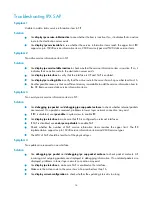
10
IPX configuration example
Networking requirements
Figure 1
shows the network requirements.
Router A and Router B are connected through an IPX network. The IPX address of Ethernet 1/1 on Router
A is 1000.00e0-fc01-0000 and that on Router B is 1001.00e0-fc01-0001.
The server is installed with NetWare 4.1 and its IPX address is 2.0000-0c91-f61f, packet encapsulation
format is Ethernet_II. The client is a PC. Its network ID is 3, and packet encapsulation format is SNAP.
The server provides file and printing services. The client can access these services through the IPX
network.
Figure 1
Network diagram
IPX
Eth1/1
1000.00e0-fc01-0000
Eth1/1
1001.00e0-fc01-0001
Eth1/2
2.00e0-fc01-0002
2.0000-0c91-f61f
Router A
Router B
Server
Client
Eth1/2
3.00e0-fc01-0003
Configuration procedure
1.
Configure Router A.
# Enable IPX.
<RouterA> system-view
[RouterA] ipx enable
# Enable IPX on the interface Ethernet 1/2, with the network ID being 2.
[RouterA] interface ethernet 1/2
[RouterA-Ethernet1/2] ipx network 2
# Set the packet encapsulation format on the Ethernet interface to Ethernet_II.
[RouterA-Ethernet1/2] ipx encapsulation ethernet-2
[RouterA-Ethernet1/2] quit
# Enable IPX on the interface Ethernet 1/1, with the network ID being 1000.
[RouterA] interface ethernet 1/1
[RouterA-Ethernet1/1] ipx network 1000
[RouterA-Ethernet1/1] quit
Configure Router B.


























